
Every few weeks, I go to see a woman on our island. (She prefers to remain low-key so I will just call her Jan.)
Jan is a widow in her early 70’s. She walks five miles a day, and thinks nothing of hitting the road at 4 a.m. and driving herself to Florida. I am 15 years her junior and I am not sure if I could drive myself to Florida all in one day.
Jan is a seamstress and has done dozens of alterations for me over the years, ever since I learned that in clothing, the smallest changes can make the biggest differences.
When I went to pick up some alterations from her last week I was greeted by this sign, printed by her little niece. If you need help interpreting kid speak it says, “Sewer Pretty Things.”
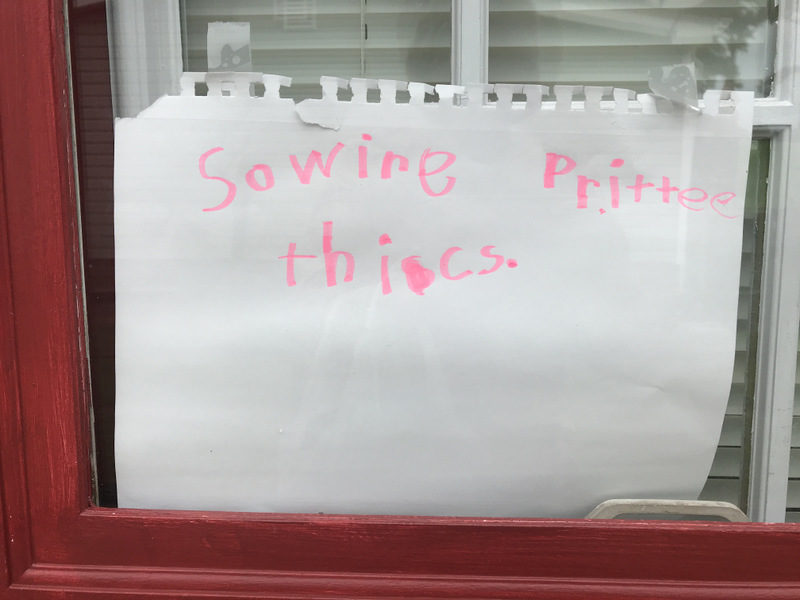
A case in point.
If those aren’t prittee, I don’t know what are.
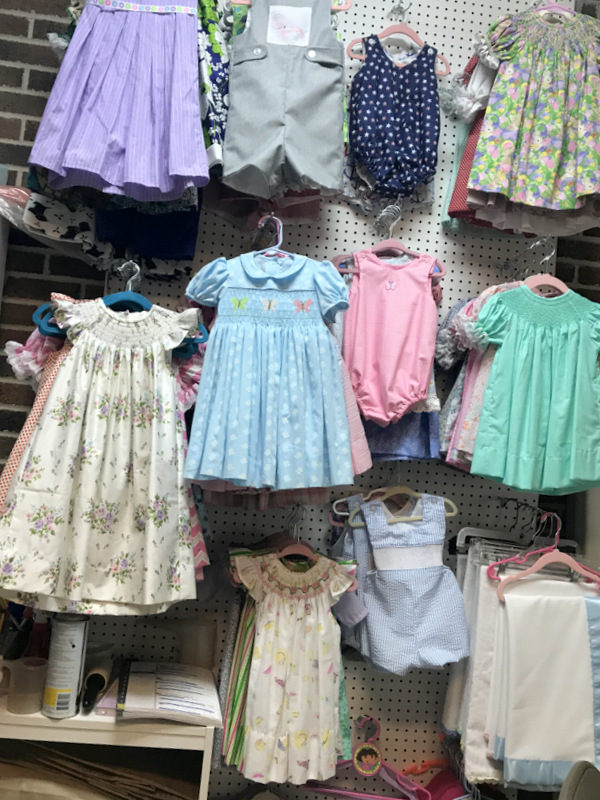
This is where Jan hangs out most of the day; a former garage turned into her sewing room.
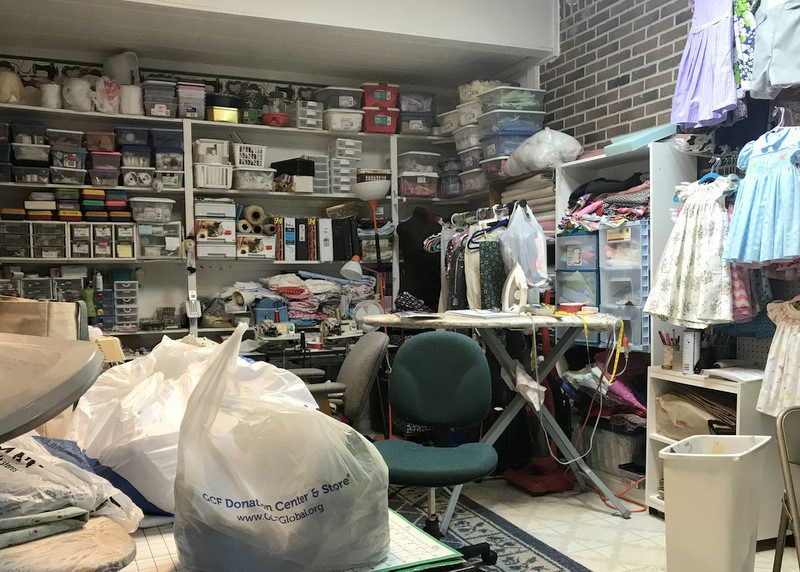
As a photographer and graphic artist, I love color in all its shades and hues. The walls at Jan’s house could give a rainbow a run for its money. (If rainbows could, indeed, run.)
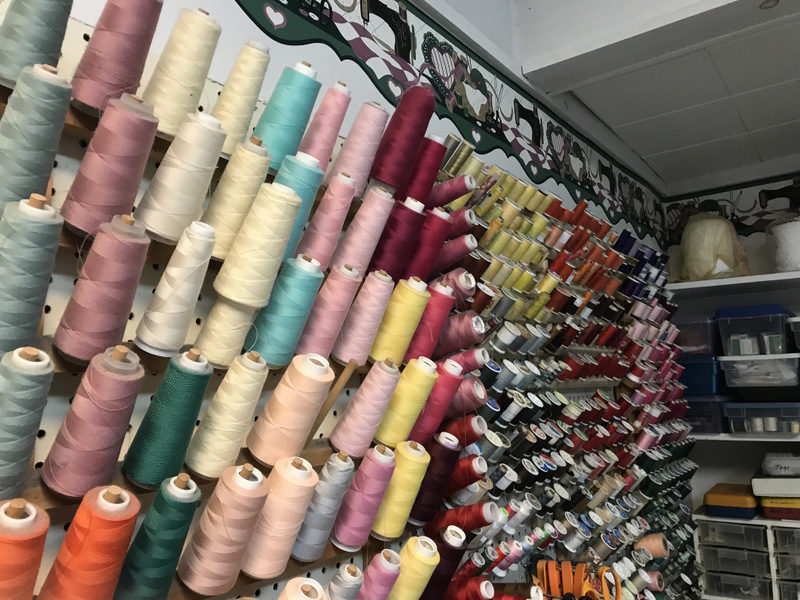
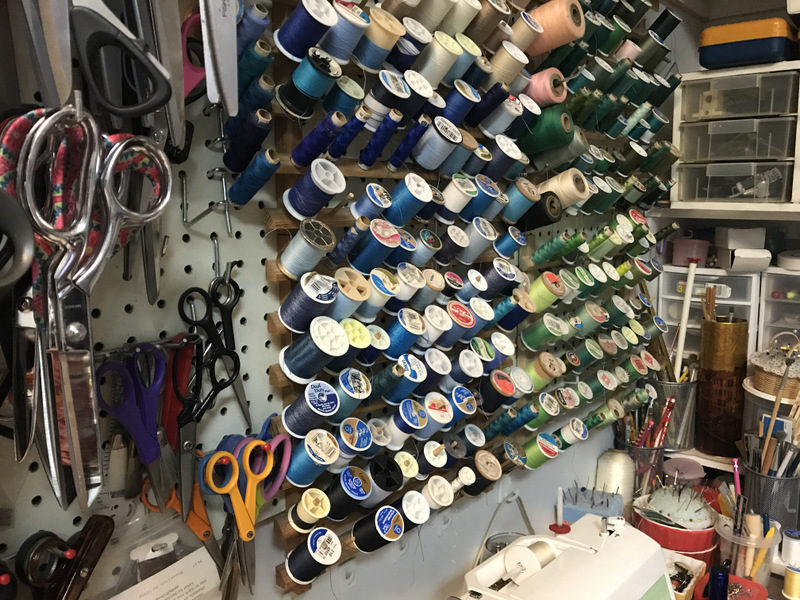
Everywhere I looked, there were reminders of her trade.
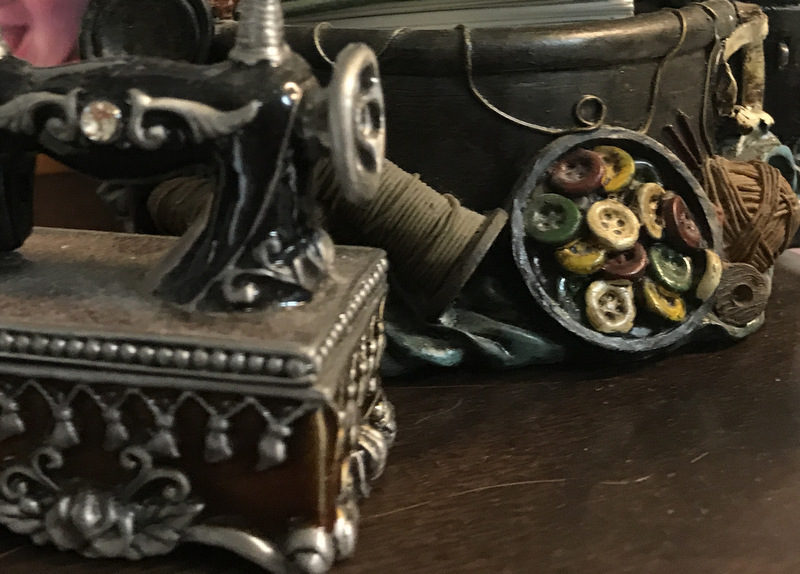
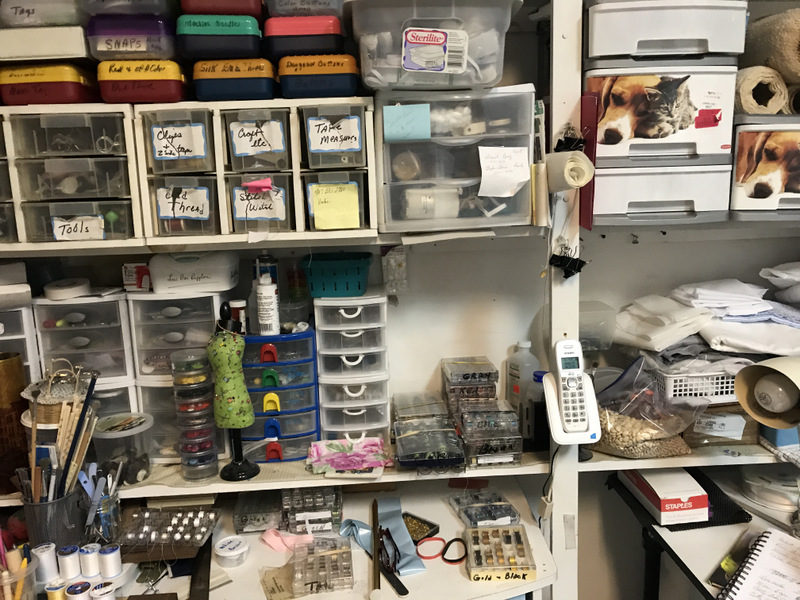
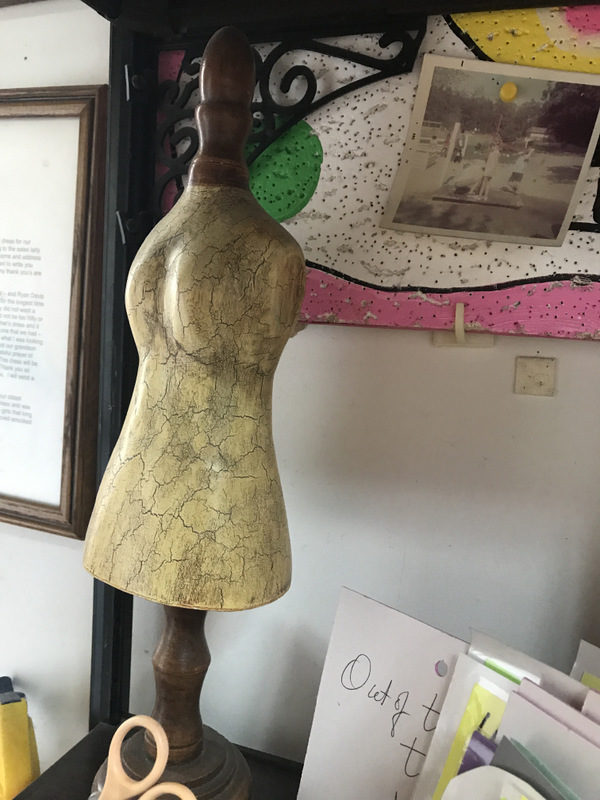
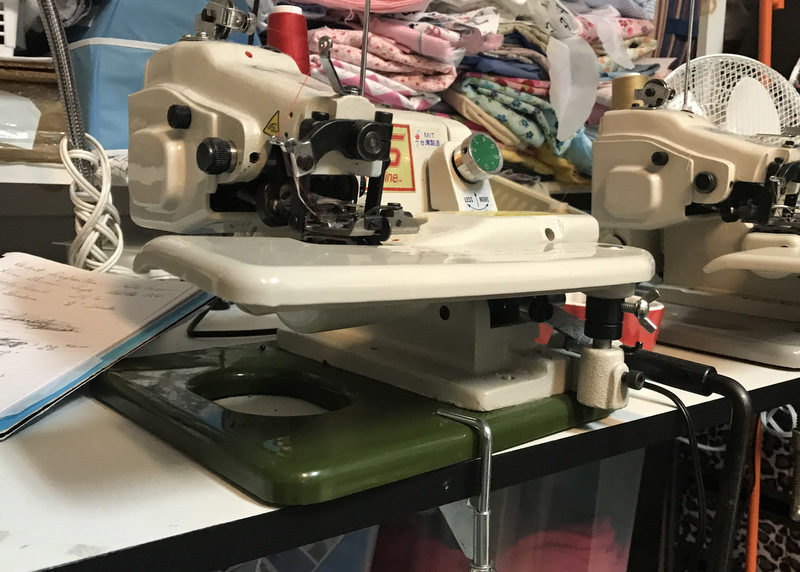

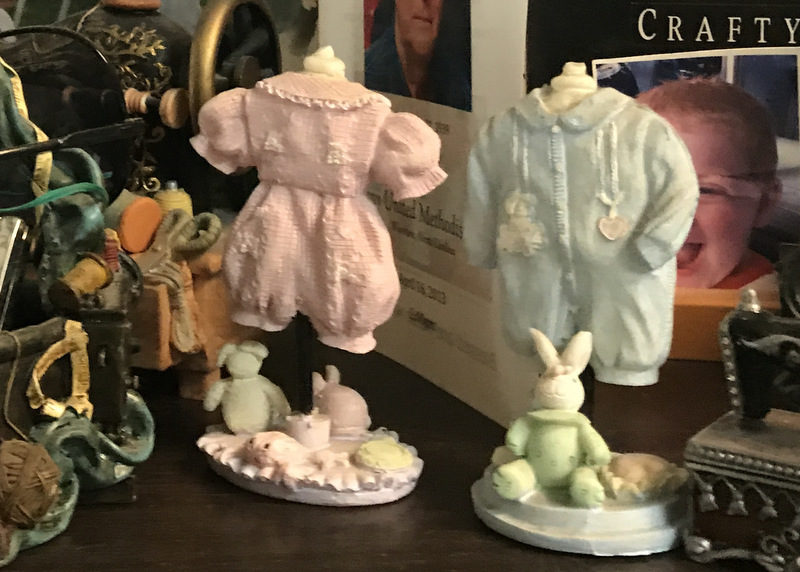
I loved seeing the hand-made fly swatters; they had so much more panache than the plastic kind you pick up at Wal-Mart.
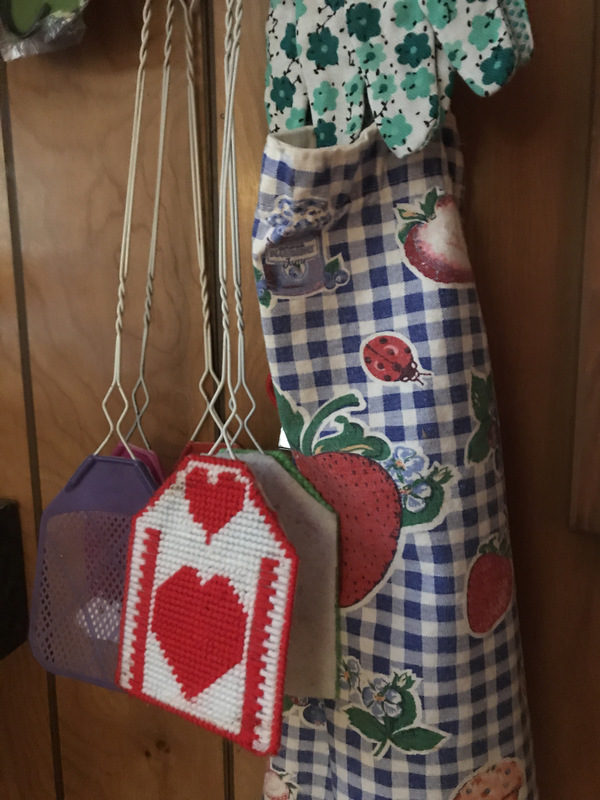
Here are some of the signs that Jan has printed up to let her customers know why she isn’t home at a particular time. I love this kind of small town charm.
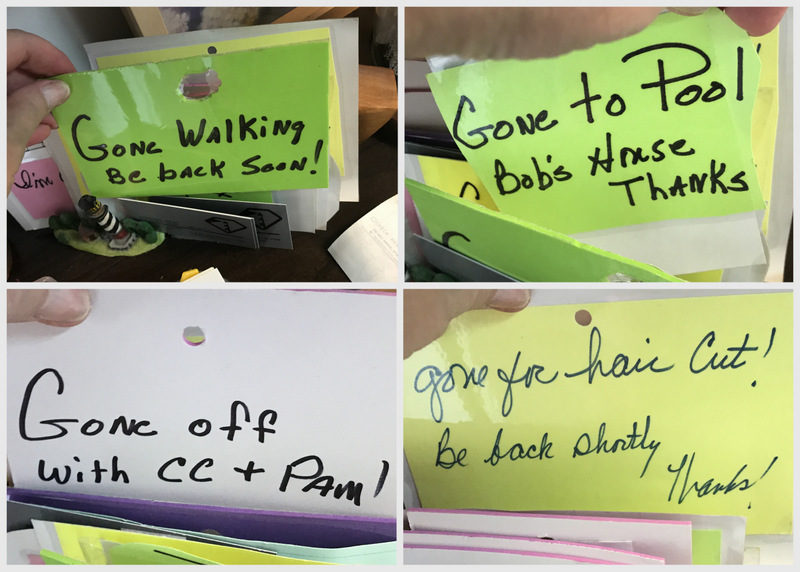
The favorite thing I saw on this recent visit was fabric that had been salvaged from feed sacks.
Back in the 1930’s and 1940’s, when the manufacturers of feed sacks realized that women were reusing the sacks to make clothes and dish towels, they started adding colorful patterns to the sacks in order to encourage people to buy more sacks. Jan told me that it took three sacks for her mother to makes a dress for her and her sister.
By 1942, over three million Americans wore at least one article of clothing made from a feed sack. Some of the sacks even came pre-printed with a pattern with which to make an apron or a doll. (You can read more about feed sacks turned into clothing here. It is absolutely fascinating.)
These two pieces of feed bag fabric are over 75 years old, Jan got them from her mother and uses them as pressing cloths.
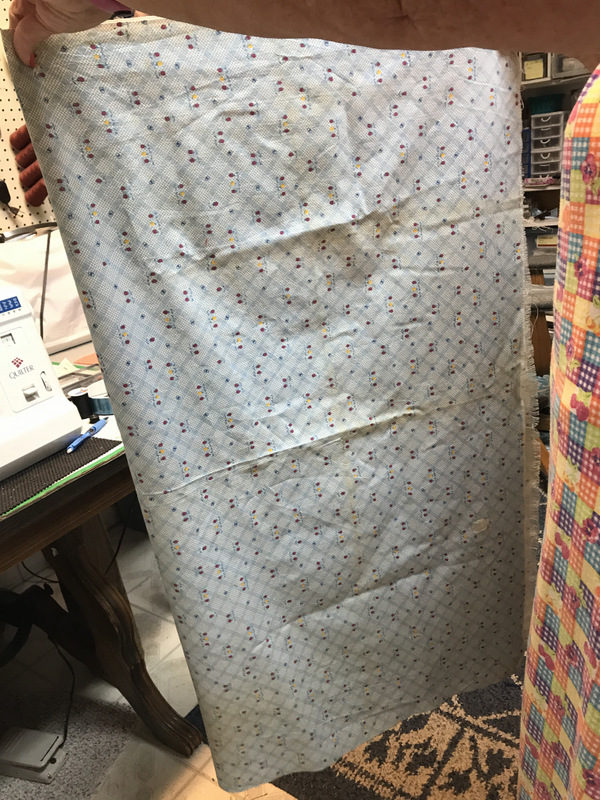
I was amazed at how well the colors have held up over the decades.
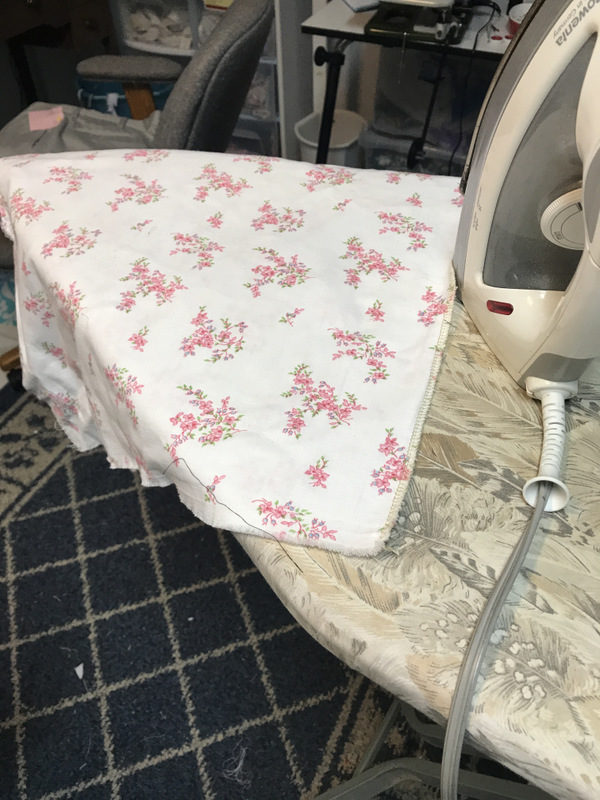
Hearing the story behind the feed bags made me think of how very different the world is now than in the war years. Now we have disposable fashion featuring styles that change every fifteen minutes. We go online and in a matter of minutes, we can order a whole wardrobe in any size, color, and style we want. And when we get tired of those clothes, we can just get some more.
None of us will ever experience what it’s like to have to wait for one’s dad to buy three matching feed sacks, then wait for all the feed to be used up from the sacks, and then wait even longer for a busy mother to wash the sacks and stitch up two matching dresses.
I can only imagine the kind of appreciation those people had for every single item they owned. They couldn’t go on their Amazon app and have a favorite book delivered within a day. They couldn’t walk into a mall and be presented with every kind of doodad or clothing item imaginable. Things came to them slow and hard and appreciated.
In an era of overabundance, it’s easy to lose the joy of simplicity, the beauty of having just enough.
I once heard a missionary tell the story of coming home to the U.S. after spending four years in an impoverished country. The first day she went to the grocery store and tried to buy breakfast cereal, she just stood in the aisle and wept, simply because she was so overwhelmed by the choices.
I’m not saying I want to go back to the days of paucity and feed sack dresses. I’d be the first to say that I love all the colors and the variety of styles in my closet.
But I do want to take a moment to honor those hard-working women who lovingly stitched those feed sacks into dresses. And I also want to honor the daughters who put those dresses on and wore them to church feeling pretty and abundantly blessed–even though they might have seen a feed sack dress with the same pattern two pews down.
It seems ironic that the place where I saw that feed sack fabric was a room filled with all the tools and supplies necessary to make any kind of custom-made garment you could want. And yet every time Jan picks up one of her feed sack pressing cloths, she is briefly transported from modern seamstressing into an earlier era. What a grand way to stay in touch with what was. What a special way to honor the creativity, the frugality and the simple joy of the women who went before us.
These were wartime women who didn’t rely on Amazon to furnish their homes or Kohls to clothe their families. They didn’t need Harris Teeter to help them get dinner on the table. They were the very epitome of self-reliance and steely strength.
And in the middle of the hardest of times, when the country was grappling with wartime shortages, these women didn’t bemoan what they didn’t have. They looked around and found what they did have–bags of feed made of perfectly good cotton.
And so they grabbed that cotton and they got busy creating beauty with needle and thread and love. And any one of them could have proudly hung this sign on any of their rickety screen doors: Sowire prittee thics.
I am newly inspired by those feed sack stories and by those women who didn’t often have what they wanted, but who so often wanted (and put to use) what they had.
What about you? Do you have any stories (your own, or from a grandparent) about making do with things during times of hardship and shortages? Inspire us. Tell us your story!
My mom could sew. She made my sister’s wedding dress and several of my dresses for school dances. I can sew a pillow….
Jstory,
Well, sewing a pillow is more than I can do! 🙂
I am in awe of anyone who can sew a wedding dress–or any dress at all, for that matter!
Becky, sewing isn’t difficult at all, you just follow the instructions on the pattern. With the cost of fabric getting so high, it seems more economical to just buy ready made. Knowing how to hem and alter things does come in handy though.
I also still have a quilt that my Nana (Mom’s Mom) made for me. She made one for all of her grandchildren.
Kari,
Well, I tried it once back in school and decided it wasn’t for me. But you’re right. With the cost of fabric and the time involved, ready-made clothing just isn’t that expensive, comparitively speaking.
How very cool! I absolutely LOVE smocked baby clothing! For the first 5-7 years, my mother-in-law made my daughters coordinating Christmas dresses, and sometimes other holiday themed dresses. Later she used scraps of the material to make quilts for them. It’s so fun seeing the squares and remembering the sweet outfits made from them.
Sue Ellen,
Yes, I love it when people make quilts out of pieces of fabric that are special to them. I even heard recently about an engaged couple asking everyone who received an invitation to send (or bring) a square of special fabric for the couple to put into a quilt.
Oh, and the thing that makes the story about my grandpa truly amazing is that he had only an eighth grade education because he too had to quit school in order to help support his family!
LeeAnne,
Your grandpa obviously had incredible natural skills to be able to fix airplane engines without training.
Steve’s grandpa also quit school in 8th grade to care for the family and farm after his dad died. Kids who complain about having to go to school have no idea how good they have it!
I have heard of feed sacks but I never knew people made clothing out of them! Must have been very good cotton to have held up that long! It is hard to buy good cotton clothing now.
Jan’s sewing room looks like a very interesting place, I would love to have a large room for my hobby stuff. We don’t have a garage and the basement is filled with fishing and hunting stuff.
My Mom sewed most of the clothes for my sister and I when we were young. She also made most of her clothes. She loved to sew! I do remember her doing the smocking on dresses.
I don’t sew much anymore but I did make my wedding dress and veil and headpiece. I think the headpiece was like six layers of stuff ( lace, satin, interfacing, etc.) The dress was a combination of several patterns. I have had the fabrics for several years to make a Catkin quilt, but I have yet to even start on it, lol! Too many other things come first.
Kari,
Ok. If you sewed your own wedding dress/veil you are on the list of the World’s Most Elite Seamstresses. Wow!
I’m assuming you learned all your skills from your mom since she did so much sewing. That makes my heart happy to see such a wonderful talent passed to the next generation.
Loved seeing Jan’s supplies and clothes. i especially like the smocking…. that’s a lost art. Two of my Goddaughters’ (sisters) Mom made them the most adorable smocked dresses.
I wish I could say my sewing supplies were so neatly organized in my small bedroom… my serger threads are piled on top of each other in boxes, and regular spools are dumped in a basket. 🙂
My sewing skills are quite limited, but I am happy with being able to make SIMPLE dresses for little girls in Nicaragua and in care at St. Louis Crisis Nursery, and chair covers for Preschool.
Mrs. Pam,
The smocked items are so beautiful; they remind me of another time and another era.
BLESS YOU for using your sewing skills to brighten the lives of children who truly need the clothing you make. You inspire me!
I hate this era of too much stuff. I hate how much I give into it as well. I’m in the process of trying to figure out how to not have to rent anymore, yet I live in a town where your average middle class person can’t buy (don’t ask, the west coast is just stupid stupid stupid), so I’ve thought about buying an Airstream trailer instead, because THAT I could afford. Some people think I’m wonky, but others understand my want to downsize and get rid of all.my.stuff.
Brooke,
I understand the high cost of living; Manteo has 30% higher housing costs than just an hour away. I am sure parts of the west coast are even higher.
As you know, we lived, quite happily, in RV’s for 15 years with an entire family. There is great joy in paring things down to the minimum. I think it would be a great adventure for you to try RV living. I am a big proponent.
I own several old feed sack quilts I’ve bought over the years. I love old things! I use these old quilts regularly too, there’s something comforting about them. Some of them you can even see and feel the bits of twig or boll from the cotton inside. Most still have the printing on the back of the quilt, very faint now, showing what was once in the sacks such as ’25 lbs chicken feed,’ etc. I can remember my grandmother telling me about having clothing, specifically underwear, made from feed sack material, and how she hated it whenever the print saying “25 lbs.” would end up right across the back of her underwear!
Melissa,
How cool that there are quilts make from feeds sacks. I didn’t know that. Think of all the memories encompassed in those squares.
And the underwear story? Hilarious. I can’t imagine the feed sack underwear being real comfortable but it would certainly make matters even worse to have “25 lbs.” written across one’s back side!
Thanks for sharing that story.
I don’t have any stories but I do have some dish towels made from feed sacks – probably not like the ones of many years ago though. My mom used to buy the plain ones and turn them into dish towels, either painting on them or embroidering. Some days I think it would be nice to go back to simpler times. Then I remember there was no air conditioning then and decide maybe not.
In answer to your question from your last post, yes I did retire the end of June.
Phyllis,
What a creative mom to paint on a dish towel. I love the idea of personalizing and beautifying something she used every day.
And you’re right. The olden days have their charm but not having air conditioning would pretty much wipe out that charm!
I was watching something on TV last week and there was a bunch of chickens roaming the yard of a farmhouce. I don’t know why / how but I immediately thought back to the late 40’s when my mother and father had quite a few chickens and othe critters. Dad would buy feed in cloth sacks. Mother and my aunt would make dresses, top’s and shirts for the family. I can also remember collecting fresh eggs daily. Not sure how I can remember this but can’t remember what I ate for dinner yesterday.
John,
How cool that you have those feed sack memories! It’s one thing to read about them on the internet but another thing altogether to know people personally who wore feed sack clothes. Whoever had the idea of putting the patterns on the sacks was a genius!
And I can certainly relate about your “long ago” memory being better than your “yesterday” memory. Same thing happens to me. 🙂
My dad just recently told us about when he was a young boy during the dust bowl. His dad, my grandpa, was a wheat farmer in western Nebraska. Well, there were several years where there were no crops, so times were very hard. One day grandpa was checking out his fields when he heard a plane overhead that had a very rough running engine. It was flying fairly low, so he signaled the pilot to land. Grandpa looked the plane over, made a couple of adjustments and the plane was running like a top. A few weeks later, the same pilot flew over again with another mechanical problem, so he landed, grandpa fixed it and he was on his way. Some time later, a big, black fancy car pulled into grandpa’s yard. It was the CEO with Boeing. He was offering grandpa a job as their lead mechanic! Grandma was THRILLED! But guess what? He didn’t take the job! He said ‘I’m a farmer. It will rain again’. Oh my grandma was so angry!! They lived on what she made as a school teacher so her job was so necessary. When dad was about 8 towards the end of the dust bowl, grandma found out that she was pregnant and the next day when she went to school, it was boarded up. She lost her job because there were no kids going to school. They were all out working to help support their families. Talk about tough! I cannot even imagine the rough life they lead! But they made do with what little they had and they survived!
Grandma sewed so I’m sure she made a feed sack dress or two in her time. 🙂
LeeAnne,
What wonderful stories! Your grandpa must have made quite the impression to be offered a job by the CEO of Boeing. I truly admire the way he knew himself, his talents and what he wanted to do with his life and turned down a lucrative offer to do what he was obviously born to do. That takes a lot of guts. (But I CAN imagine that it was upsetting for your grandma.)
And the story about the school being boarded up because all the kids were out working just hurt my heart. Those people truly knew the meaning of hardship. They were amazing survivors!
I LOVE this post! I would love to go to Jan’s little shop and look at everything. I don’t sew, but I love all the old things. I read a lot of Historical Christian fiction and my favorite time period is late 1800’s and early 1900’s. Everything was so simple. I would love to transport myself there!
Krista,
Yes, you would definitely love her little spot!
That time period was definitely an interesting one. So many things were changing as the century changed; stories from that time are truly fascinating.
Thank you for the interesting information about the feed sack material. I enjoy looking for older patchwork quilts on ebay and many proudly proclaim ‘feed sack material’. I figured this was supposed to be a good thing but didnt really know why. Now I do.
I only had one grandparent while growing up and she never really spoke of any hardships, although being born in 1899 and living in Provincetown on the very tip of cape cod back in the day, basically out in the middle of the atlantic ocean, must have been very hard. I wish I had more of those kind of stories from her.
Lesley,
Well, I’m glad I have been able to contribute to your official Feed Sack Education. I found it to be truly fascinating.
Oh my. I can only imagine all the hardships your grandma endured living in such an isolated place and dealing with those bitter winters by the sea. I would have loved to have heard her tell her stories.
Great read.
Steve,
Great reader! 🙂
I remember the feed bags. My grandma used them. We had some but I don’t think Mama ever made us dresses from them. She made many of our clothes. I believe she wore clothes from feed bags when she was growing up.
Ann,
It’s amazing to me how well women were able to sew back in those early days. I guess it was out of necessity; you either sewed, or you had nothing to wear. It was an important skill passed down from mother to daughter. I hate that somewhere along the way, it wasn’t taught so much anymore. You were blessed to have a mom who made so many of your clothes!